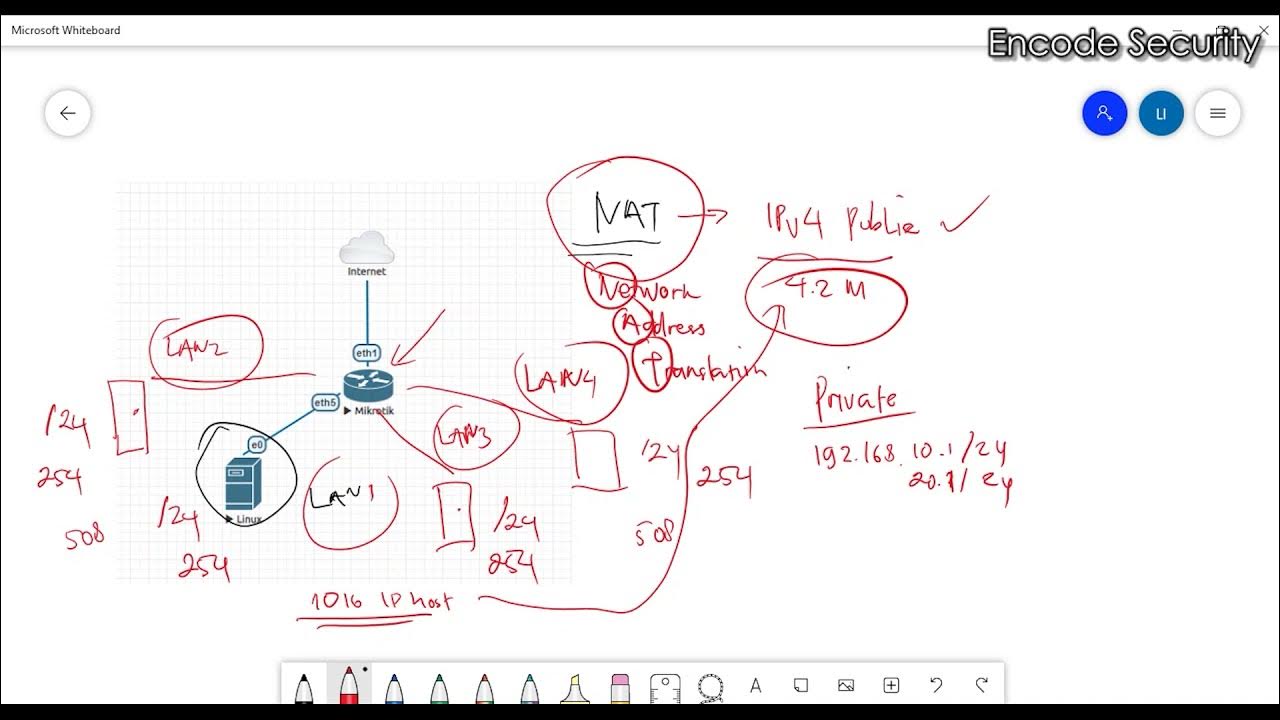Lec-62: NAT Explained - Network Address Translation with example in Hindi
Summary
TLDRIn this informative video, the concept of Network Address Translation (NAT) is explained using relatable real-life examples, such as university hostels. NAT allows for the conversion of private IP addresses to public IP addresses and vice versa, enabling multiple devices within a private network to share a single public IP. The video highlights the importance of NAT in efficiently managing IP addresses in a world where the limited availability of IPv4 addresses poses challenges. Additionally, it touches upon the upcoming transition to IPv6, which offers a vast number of IP addresses, reducing the reliance on NAT.
Takeaways
- 😀 NAT (Network Address Translation) translates private IP addresses to public IP addresses and vice versa.
- 🏢 NAT allows multiple devices in a private network to share a single public IP address for internet access.
- 🔑 Private IP addresses can be reused in different networks, enabling efficient IP address management.
- 📍 NAT creates a translation table to map private IP addresses to public IP addresses, facilitating bidirectional communication.
- 🌐 The use of private IP ranges (e.g., 10.x.x.x, 172.16.x.x, 192.168.x.x) helps conserve public IP addresses.
- 📦 Port Address Translation (PAT) allows multiple devices to connect to the internet using the same public IP address by differentiating traffic through port numbers.
- 🔄 NAT operates by modifying packet headers to replace private source IPs with public ones when accessing external networks.
- 🌍 The internet recognizes organizations by their public IP or domain name, not by the private IPs used internally.
- 🖥️ With IPv4's limitations (around 4 billion addresses), NAT plays a critical role in managing IP address scarcity.
- 🚀 The transition to IPv6, with its vast address space (2^128 addresses), may reduce the future reliance on NAT.
Q & A
What is the primary function of Network Address Translation (NAT)?
-NAT primarily translates private IP addresses to public IP addresses and vice versa, enabling devices within a private network to communicate with the external internet.
Why is NAT necessary in networking?
-NAT is necessary to conserve limited public IP addresses, allowing multiple devices on a private network to share a single public IP address.
Can private IP addresses be reused across different networks?
-Yes, private IP addresses can be reused across different networks because they are not routable on the internet.
How does NAT handle outgoing packets from a private network?
-When a device in a private network sends a packet to the internet, NAT changes the source address from the private IP to the public IP before forwarding it.
What happens when a response packet returns to the NAT device?
-When a response packet returns, NAT uses a translation table to map the public IP back to the original private IP, ensuring the data is sent to the correct device.
What role do port numbers play in NAT?
-Port numbers are used in NAT to manage multiple connections from the same private IP address, allowing different applications to communicate with the external internet.
What is an example of how NAT works in a university setting?
-In a university, each hostel can use the same private room numbers (IP addresses) internally, while the entire university is identified by a single public IP address for external communication.
How many unique IP addresses does IPv4 provide?
-IPv4 provides approximately 4.3 billion unique IP addresses due to its 32-bit addressing scheme.
What advantages does IPv6 offer over IPv4 in relation to NAT?
-IPv6 offers a vastly larger address space (2^128 addresses), which reduces or eliminates the need for NAT since each device can have a unique public IP address.
How can organizations create their own private networks using NAT?
-Organizations can create private networks by assigning private IP addresses from designated ranges (e.g., 10.0.0.0/8, 172.16.0.0/12, and 192.168.0.0/16) for internal use.
Outlines

Cette section est réservée aux utilisateurs payants. Améliorez votre compte pour accéder à cette section.
Améliorer maintenantMindmap

Cette section est réservée aux utilisateurs payants. Améliorez votre compte pour accéder à cette section.
Améliorer maintenantKeywords

Cette section est réservée aux utilisateurs payants. Améliorez votre compte pour accéder à cette section.
Améliorer maintenantHighlights

Cette section est réservée aux utilisateurs payants. Améliorez votre compte pour accéder à cette section.
Améliorer maintenantTranscripts

Cette section est réservée aux utilisateurs payants. Améliorez votre compte pour accéder à cette section.
Améliorer maintenant5.0 / 5 (0 votes)






